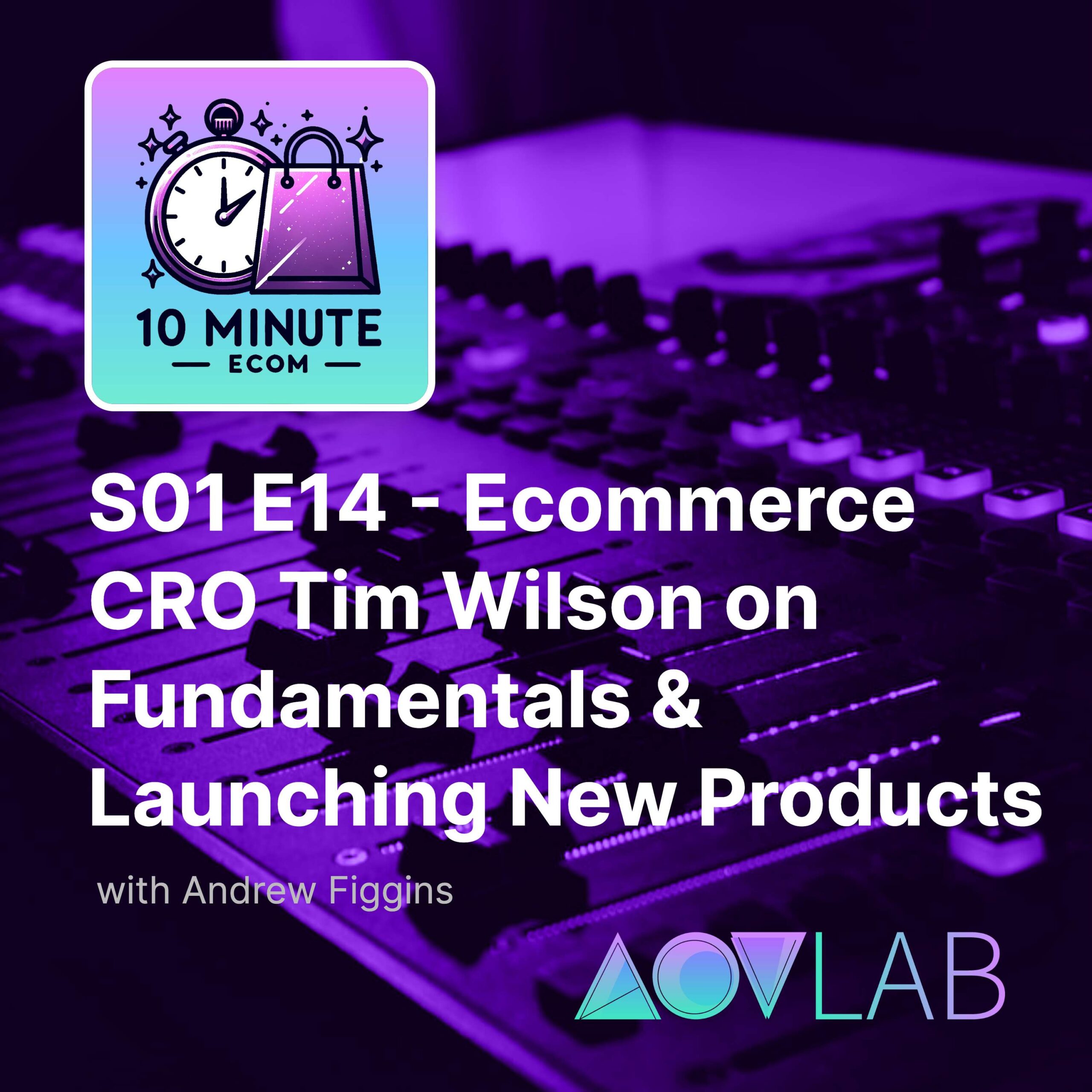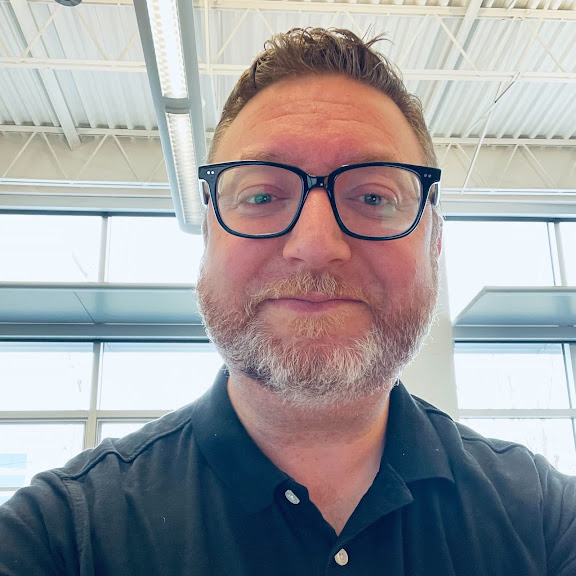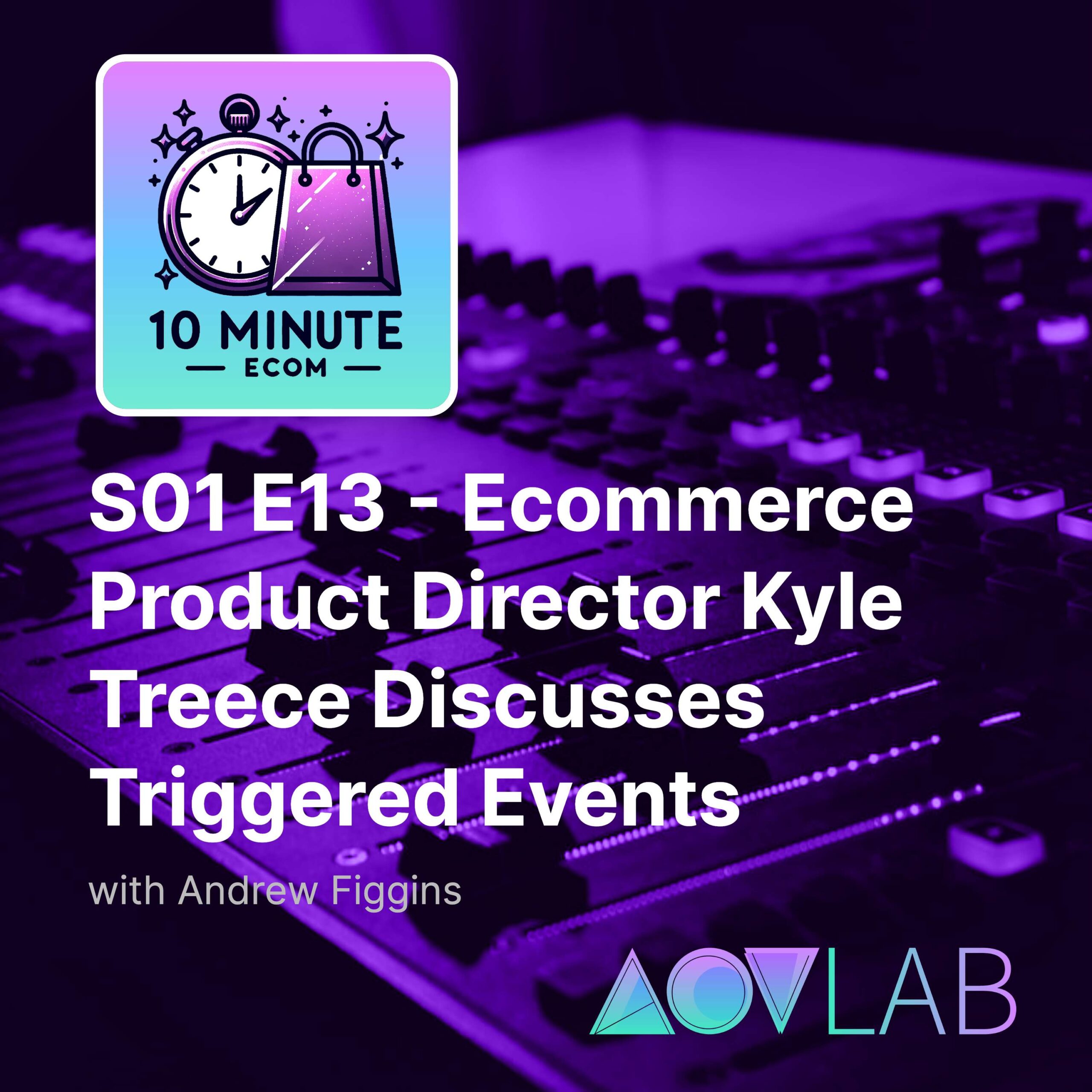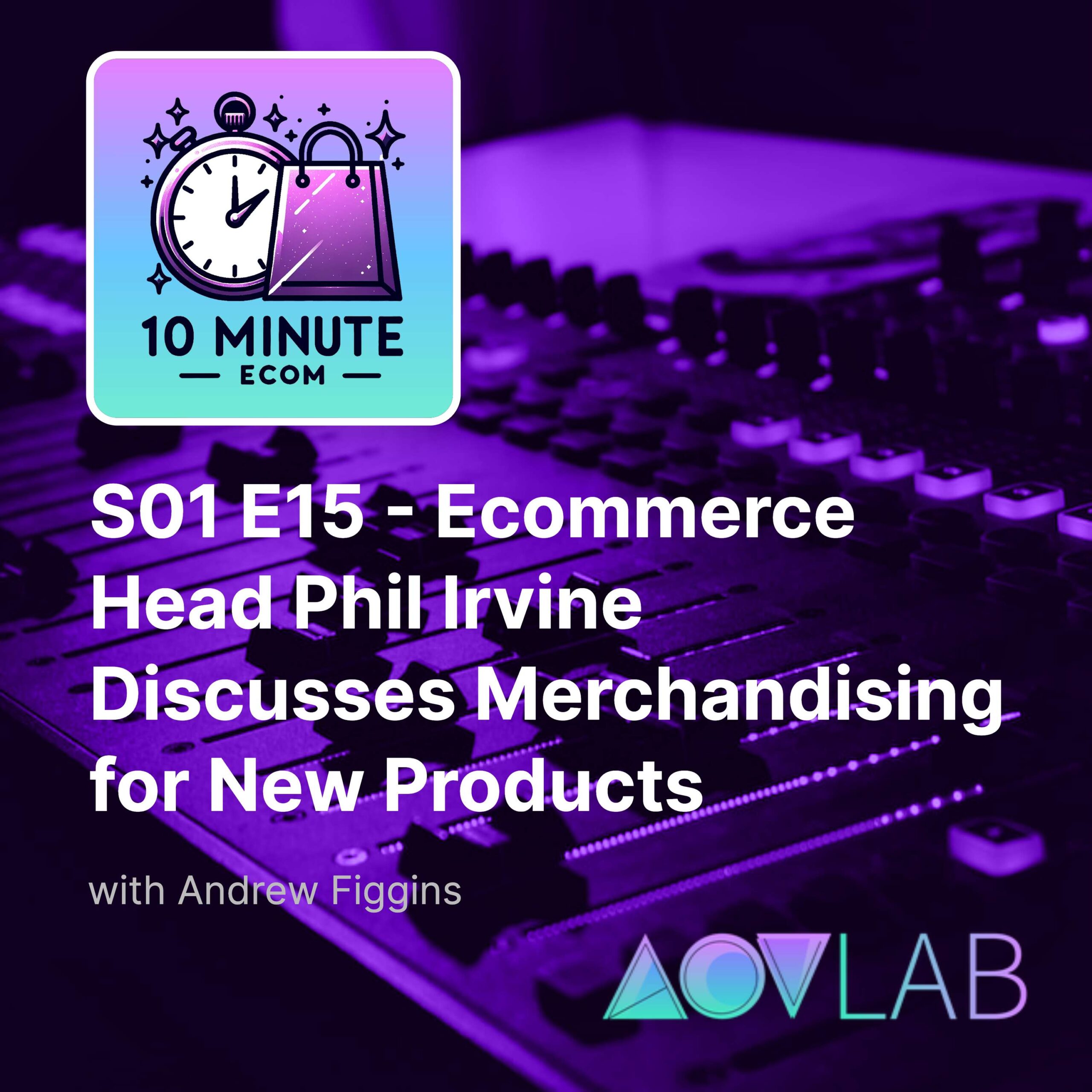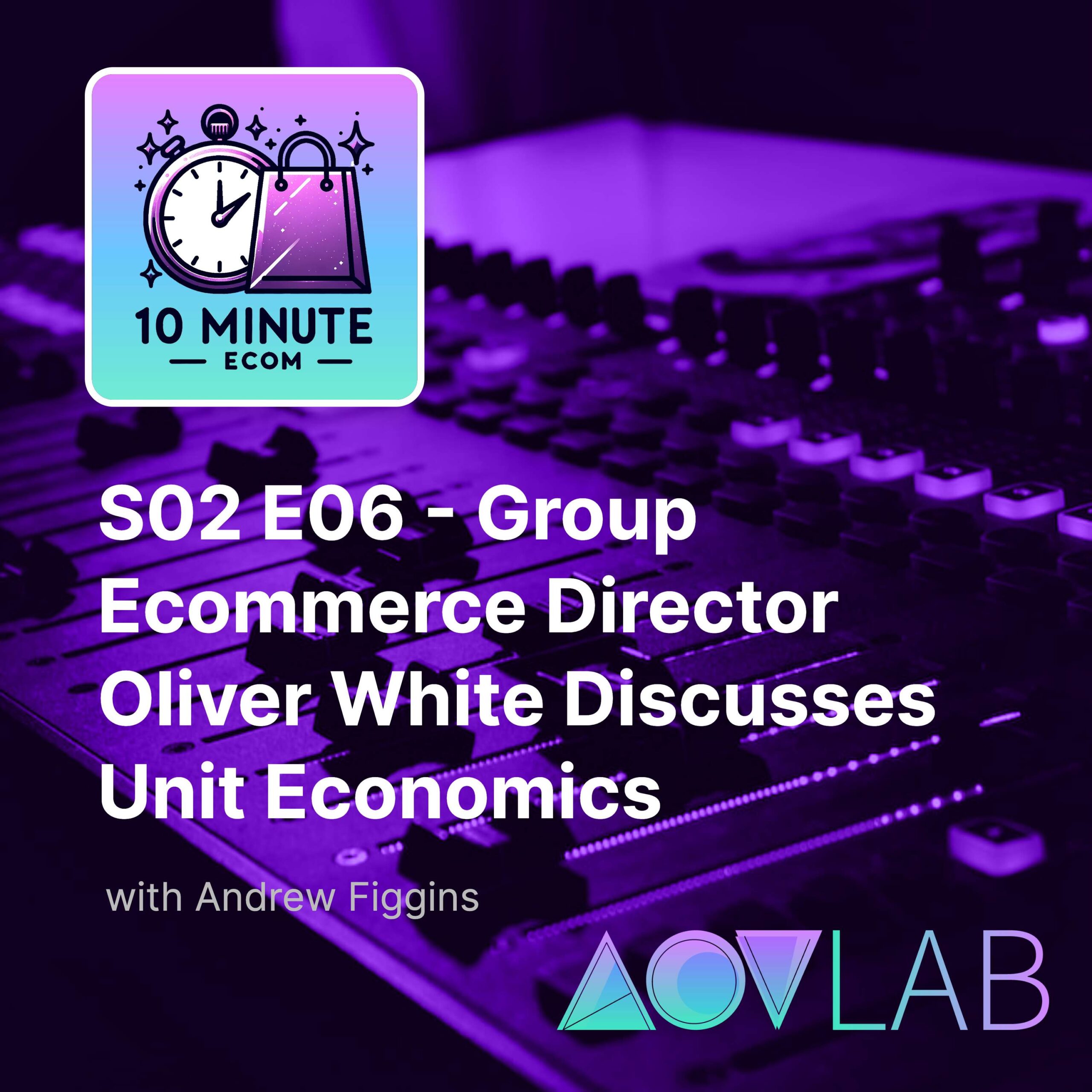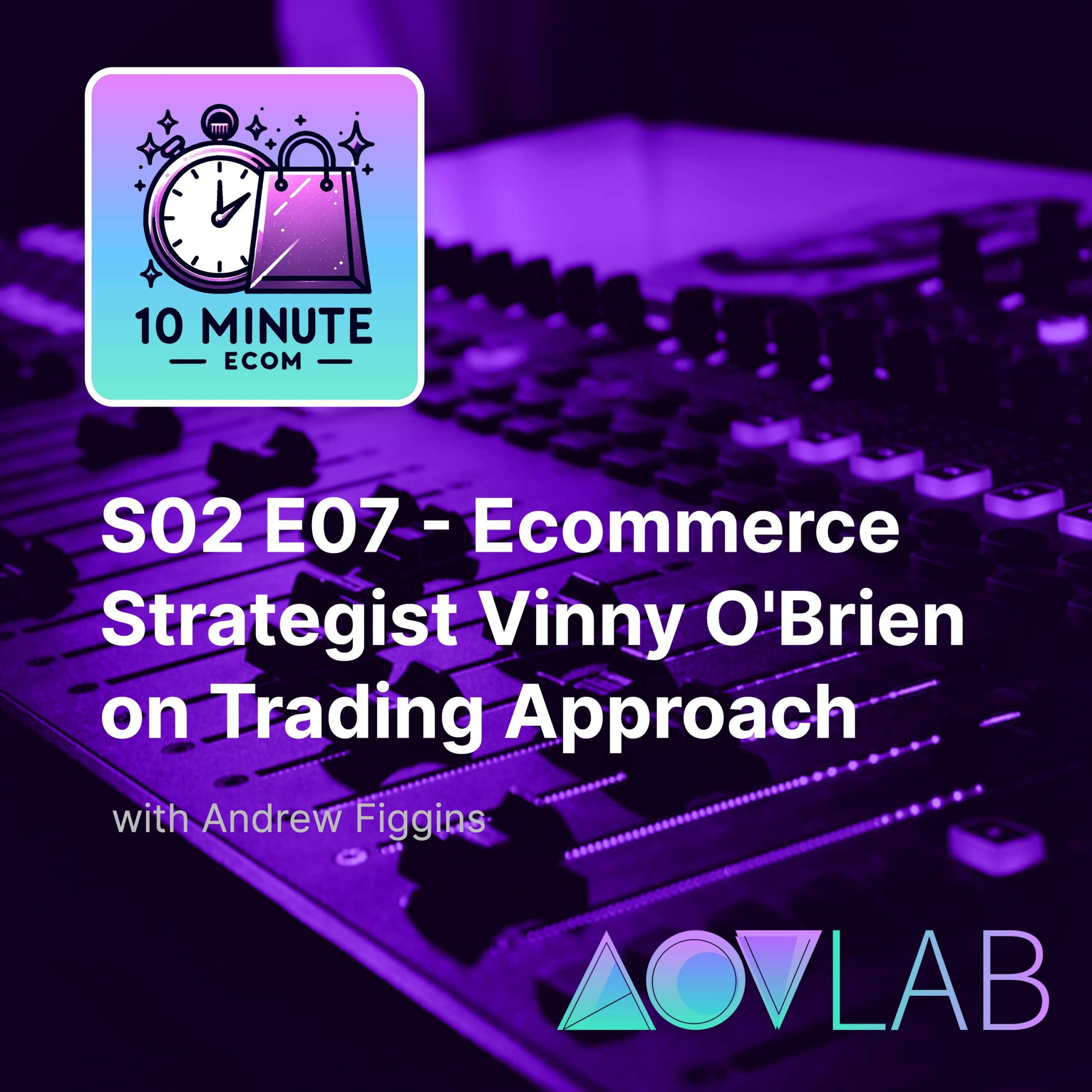Guest: Tim Wilson, Chief Revenue Officer, ProductWindHost: Andrew Figgins, Founder, AOV Lab Episode Synopsis:Tim discusses the importance of paying attention to Ecommerce fundamentals, as well as how to leverage social to launch new products faster and more effectively. Transcript: [00:00:15] Andrew: Hello Ecommerce fans, and welcome to 10-Minute Ecom, an AOV Lab podcast. Every episode, we break down a new and different tactic that can help you improve your ecommerce KPIs (key performance indicators). I’m your host, Andrew Figgins, and like most of you, I am an e commerce professional. You may know me as the founder of AOV Lab, the […]
View Full Transcript
Episode Transcript
[00:00:00] Speaker A: You.
[00:00:05] Speaker B: Hello, ecommerce fans, and welcome to ten minute Ecom, an AOV Lab podcast. Every episode, we break down a new and different tactic that can help you improve your ecommerce KPIs key performance indicators. I'm your host, Andrew Figgins, and like most of you, I am an ecommerce professional. You may know me as the founder of AOV Lab, the former vp of digital product innovation at Scrubs and beyond, the former director of e commerce technology at Rural King, or just from LinkedIn.
Today I'm excited to be talking to Tim Wilson, an e commerce colleague that is doing some very interesting work in e commerce at his company, productwind. Anyway, Tim, what did you come on the show today to share with your e commerce colleagues?
[00:00:46] Speaker A: Hello, I'm Tim Wilson, and I am from Productwind. I live in San Diego, and productwind is a completely virtual company where our employees are all over Canada, the US, and Latin America.
One thing that I've seen that works in ECOM, there's really two things that are jumping through my head. But the first thing is really, I think, the most important, which is getting your fundamentals right.
[00:01:12] Speaker B: Thank you, Tim. And after the ad, we'll get right into the chat.
Today's episode of ten minute Ecom is brought to you by espresso. Espresso's pricing optimization technology can bring your brand anywhere from a ten to 15% improvement in conversion, in profitability, or a mix of both, depending on how you set up your pricing optimization strategy, which can be on a subset of products or on your entire store. AOV lab is helping espresso grow in the US. So if you're a us based merchant and want to learn more, go to aovlab.com and click on vendor network to set up an intro call with Espresso today.
And now back to the show, and we'll jump right in with Tim Wilson describing some of those fundamentals that e commerce retailers need to pay attention to.
[00:02:01] Speaker A: Michael Jordan still does the layup line in practice, shooting free throws, right? Tom Brady still practiced taking a snap in his footwork. And it's amazing to me how many companies I talked to, how many brands and their catalog was not optimized. For the retailer.
The hero image isn't great. The image stack isn't optimized. With the video and the title of the product detail page, I feel 15 years of doing this, and I feel like if everyone was honest about have I truly done the fundamentals correctly across my catalog, most people have areas for improvement there, and that's where I would always start.
[00:02:42] Speaker C: Absolutely, Tim. And welcome to Tim and EcoM today. I love that there are not just one or two things. There are so many things that so many tactics, technologies out there that our Ecom peers and colleagues bring to the table. I love what you're bringing to the table today, starting with the basics, but you've got something that you've done that even goes a level deeper as well, which is that you've worked and your software has worked with social media influencers. Can you talk about that a little bit?
[00:03:13] Speaker A: Yeah, absolutely. If you have your fundamentals in place. One of the things that I have seen work honestly better than I even expected, having done this, is using social to drive ecommerce KPIs. So in the world of social, I feel like it's still just a lot of semantics and people don't necessarily understand nuances or differences. It's like saying in 2023, saying you're in social is like in 2009, saying you're in online advertising. People are like, okay, that's great. But today, if you said you're in online advertising, you have to be way more specific because there's so many different things that you can do that need different skill sets and deliver different results. And that's where we are with social. Social doesn't just have to be a form of pr. It doesn't just have to be reach and engagement. And what we've found, I guess the real found, is that if you want to have an unfair share on Amazon or Walmart or any of these retailers websites, you have to understand their algorithm. And that we found that social is the best way to train the algorithm into loving it.
[00:04:34] Speaker C: I think that's super interesting. And if you're willing to, Tim, I'd love to hear a little more detail about how do you get the algorithm to love a product. I'm super curious about that.
[00:04:46] Speaker A: Yeah. So the trick is if you go talk to social companies, they'll talk to you frequently about the demographics and psychographics of the influencer or the creator, depending on their level. And those are important. It's important that you have a person who looks like your brand. If you're doing a social post, however, the real thing that you need to know isn't the demographic and psychographic. You have to go a little bit deeper than that and understand their behavioral tendencies and their behavioral profile and understanding more of who this person is and what their activities and actions are likely to deliver. So you don't have to use product wind for this at all. Product wind is just one of the options, anybody who can then find and assemble a team of people who have the behavioral attributes that you need and then have them conduct or execute different social strategies for you over call it a 30 day window, can then train the algorithm. The algorithm. Let's just talk about Amazon. Because it's usually the biggest from a distribution channel for Amazon, there are a lot of different things that you need to help influence the algorithm. And certainly external traffic is becoming more and more important as they look to conquest the rest of the world. But it's not just external traffic, really the most important thing is sales velocity and conversion rate.
And if you can show external traffic driving up your sales velocity and your conversion rate week over week, what that tells the algo is this product is relevant. This is the thing that people want to buy. And what Bezos has famously said, right, I'm not in the business to help you sell things. I'm here to help people buy. So if you can signal to the algorithm that your product is super relevant and what people want to buy, there's tremendous upward pressure on it. So your organic rank goes up. I strongly encourage you to run retail media, get some ams, spend behind it, and you'll see you have sponsored product rank. Your sponsored product rank will go up. So your media spend becomes way more efficient. That adds up to your share of voice growing and as share of voice is a leading indicator of future sales and market share.
[00:07:01] Speaker C: And it sounds like some brands have figured this out more than others. I know in my past when it came to launching a new product, a new asin, it is not easy. It takes a while. Anywhere from, I would say three to six months. It's arduous. What are some arrows in your quiver that you can take out and share with some of our colleagues in Ecom today about just how to speed up that process.
[00:07:26] Speaker A: So the best way to speed it up is to just again realize that if you're launching a product on Walmart, Target, Amazon, you have two customers, you have your end user that you know already, where you tell me about some person who shops at Whole Foods and owns a Labradoodle or whatever, the case is you also have the retailer's algorithm. And the better that you can market up to the boat is how you really win an outsized return. And the things that you need to do are really be able to, in your first 30 days, you want to really be able to show that compounding traffic to the listing page. So growth in traffic, you want to be able to show a strong if not increasing conversion rate and sales velocity, and if you can get all of those things lined up to work for you in your first week over week for your first 3456 weeks, that training set of data the algorithm now has on your product is so healthy and so strong, you've set yourself up for a super long run of success. There's a thousand things that can still go wrong. It's not a guarantee, but you are now in position to have a great run on Amazon.
Excellent, Tim.
[00:08:41] Speaker C: And you came on today talking about some basics and you mentioned, which I like, there's not enough time in the day to focus on every single basic for our ecommerce sites or our ecommerce apps. There's almost always a sore thumb sticking out somewhere. I was just talking about this yesterday with another guest who told me basically that he had seen the word ad to cart getting an 80% improvement over the word ad to bag. And here I am sitting here with five years of using ad to bag and I'm just like kicking myself. Like I really should have tried that a b test I wish I had while I was with scrubs and beyond.
But do you feel like there's an area know for folks who are strapped for time or have a small team? Where's an area that you think gets the outsized result just in terms of time? Focus for folks that are directors of.
[00:09:35] Speaker A: ECoM, vps of ECOm, I think you get outsized returns on the hero image and really just optimizing your traffic strategy.
If you have a strong hero image, I'm going to assume you'll have a decent image stack. So I guess there is an assumption in that. But most consumers are shopping through the image stack. They're not reading the product specifications as a general statement. So if you can get that and then optimize your traffic strategy, your conversion will be there.
I was working with a large global 1000 organization recently and we did a product win campaign for them and from our perspective worked exceptionally well from the start. We were able to five x traffic. They weren't thrilled because things weren't selling and that's not great. The goal is to drive sales and we just dive into the product detail page and comparing your product detail page to going to the best sellers in your category and just looking at what those top three or four people's detail pages look like usually reveal a fundamental difference, right? In this particular case, the company was using extremely technical language and stuffing the image stacks with a lot of words that I think didn't really resonate with people. And the top three competitors all had super clean, crisp words, simplified language that really punched you in the face with the benefit on each one. The benefit was three words long, not a paragraph. So revamping the recipe for success in your category is out there. Go mimic it so you have the similar conversion rate and then just focus on getting better traffic, driving up your share of voice through retail media and through sources that can deliver compounding external traffic.
[00:11:29] Speaker C: Awesome, Tim, and thanks so much for stopping by today on ten minute ecom. It is just a ten minute show, so we don't have a lot of time left. But before we depart today, is there anything else that you'd like to share with your colleagues and peers in ecommerce?
[00:11:43] Speaker A: Just that look, what you're doing is hard. It's hard. So stay positive and just stay curious. The answers to everything you're looking for are literally right around, you know, talk to Andrew, talk to your team, look at your best sellers, and be open to learning. And there's no doubt we'll do well. If you want any help orchestrating external traffic to your listing, I'd love to talk to you.
[00:12:10] Speaker C: Awesome, Tim, thanks so much again for stopping by today. Really appreciate your time.
[00:12:14] Speaker A: Thanks, Andrew. Take care.
[00:12:16] Speaker B: Well, we've hit that ten minute mark.
[00:12:17] Speaker C: So that's a wrap for today's episode.
[00:12:20] Speaker B: I want to again thank our guest Tim Wilson. Bear with me today. I have a very lengthy list of ways that you can support the show. If you have a moment, be sure to subscribe like or follow the show on Apple Podcasts, Spotify, Amazon Music, Google Podcasts, or wherever it is that you listen. You can also rate and review the show inside your favorite podcast app. Also, you can go to Aovlab.com and.
[00:12:44] Speaker C: Check out more episodes of the show.
[00:12:46] Speaker B: As well as our vendor network. If you can spare a half hour to take a demo of any of our sponsors, it'll be worth your time. I've hand selected a set of peer tested, proven technologies, including optiversal constructor, ecommerce, as well espresso and Shopbox AI, who we are helping to introduce to us based retail and e commerce brands and professionals. I hope you enjoyed this episode of the show. Until next time, this is Andrew Figgins signing off and saying have a good one.
